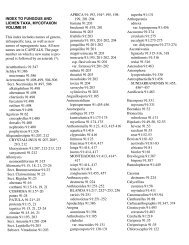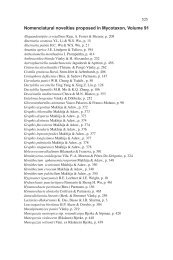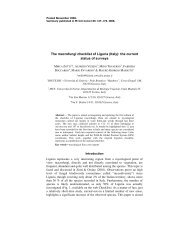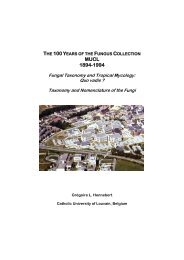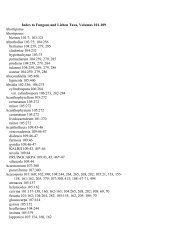download full review [pdf] - Mycotaxon
download full review [pdf] - Mycotaxon
download full review [pdf] - Mycotaxon
Create successful ePaper yourself
Turn your PDF publications into a flip-book with our unique Google optimized e-Paper software.
520 ... Hawksworth, Editor<br />
the Nordic countries, plus another 114 known from neighbouring ones that<br />
might be expected in the Nordic area. Following introductory sections on the<br />
methodology used, vegetation zones and provinces, abbreviations employed<br />
for characters and references to illustrations, and a glossary (with most useful<br />
line drawings on the terminology for spore and cystidium shapes), are the allimportant<br />
keys to genera. There are seven main keys based on easily recognized<br />
features such as fruit body types, hymenium types, and spore deposit colour<br />
– and then one to the orders covered. The arrangement is then by order, family,<br />
and genus, arranged by order and family and not alphabetically. I found — and<br />
I am sure many users will find — this most frustrating, necessitating repeated<br />
reference to the inside back cover that does list the pages on which individual<br />
genera are to be found. Preferably keys to families, and then genera, could<br />
have been collected together, and even a synoptic classification presented over<br />
one or two pages, but with the genera still treated alphabetically as is done<br />
in The Lichens of Great Britain and Ireland (<strong>review</strong>ed below). Another<br />
pragmatic refinement to consider for a future edition would be the inclusion<br />
of backtracking numbers in parentheses after couplet numbers in the keys,<br />
something I always find helpful in endeavouring to determine where I went<br />
wrong when the trail leads to a most unlikely taxon!<br />
The bulk of the work comprises descriptions of families and genera, and<br />
then keys to the species with a treasure-chest of information where they are<br />
keyed out. In addition to morphological and anatomical details necessary for<br />
a correct diagnosis, there is information on ecology, distribution, conservation<br />
status in particular countries (using IUCN categories), references to selected<br />
colour illustrations, and synonyms given in parentheses. The issue of edibility<br />
is probably wisely avoided, but poisonous or hallucinogenic species are flagged.<br />
Author citations of scientific names are provided throughout, but with no<br />
reference to the place of publication or even the year of the work; at least the<br />
latter would have been helpful, though information on both authors and dates is<br />
no longer as useful as was formerly the case as this information is now available<br />
online and free from the Index Fungorum database.<br />
Illustrations in the text are limited to line-drawings of critical features, but<br />
that is more than compensated for by the DVD attached to the inside back<br />
cover which has over 4000 coloured images, as well as PDF versions of the keys,<br />
in a new version (3.1) of MycoKey (version 2.1 is <strong>review</strong>ed in <strong>Mycotaxon</strong><br />
102: 434-5, 2007). Species featured on the DVD are indicated by a symbol of<br />
concentric rings at the end of the text where they are keyed out.<br />
The accounts are very much at the cutting edge of mushroom taxonomy,<br />
with both very recently described species and some names even in press. The<br />
latter include the new family name Chromocyphellaceae cited as “Knudsen in<br />
press” with a reference to “Petersen, Knudsen & Seberg (in press)”, but that work


![download full review [pdf] - Mycotaxon](https://img.yumpu.com/5381692/12/500x640/download-full-review-pdf-mycotaxon.jpg)
